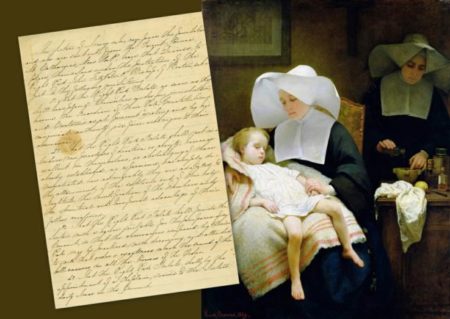 The Document outlining the conditions under which the Sisters of Mercy would serve in the diocese of Boston overlays a painting of the Sisters of Mercy by Henriette Browne. Pilot Photo/Courtesy Archdiocesan Archives And Public Domain, Via Wikimedia Commons
The Document outlining the conditions under which the Sisters of Mercy would serve in the diocese of Boston overlays a painting of the Sisters of Mercy by Henriette Browne. Pilot Photo/Courtesy Archdiocesan Archives And Public Domain, Via Wikimedia Commons
In this article, first published in thebostonpilot.com, Thomas Lester shares a document from the Archdiocesan Archives, Boston, USA outlining “the eight clear conditions under which the Sisters of Mercy would serve in the diocese.” The article dating back to 1864, gives an insight into things like Record Keeping, the building of new foundations and the courage and clarity of focus that brings forth the House where all are welcome.
On Foundation Day 2021 it is another testimony to lasting foundations.
One of the earliest religious orders to arrive in the Diocese of Boston was the Sisters of Mercy. They trace their roots to Catherine McAuley, an Irish Catholic laywoman, who saw the poverty that existed in her home of Ireland and used her own funds to open the House of Mercy in Dublin on September 24th, 1827.
The house was intended to provide shelter and an education for poor women and girls. She planned for it to be staffed by lay women but, after witnessing the good work taking place there, the Archbishop of Dublin suggested McAuley form a religious congregation to help fulfill its mission. On December 12th, 1831, McAuley and two other women became the first Sisters of Mercy.
The Sisters of Mercy first arrived in the U.S. in 1843 at the invitation of the first Bishop of Pittsburgh. Their mission and work began to attract new members so that, about one decade later, they had expanded to several other dioceses in the U.S.: from New York to San Francisco.
An item in the archive’s manuscript collection outlines the terms of agreement under which the Sisters of Mercy planned to extend their mission to the Diocese of Boston in 1864. Far from what one might expect of such an agreement today, the short two-page document is organized into eight clear conditions under which the Sisters of Mercy would serve in the diocese.
First, it was stated that by entering the Diocese of Boston, its Bishop would “become the guardian of their Rule, Constitutions and Customs … and by his canonical authority give force and vigor to their observance.” In other words, he would protect the Rule of the Sisters of Mercy that governed their daily lives, and use his authority to ensure the sisters were able to live by these practices.
Second, that the Bishop may not introduce new practices or charities to the Sisters of Mercy, nor forbid them from any practices they have already established. Essentially, this point is about the autonomy of the Sisters, allowing them to follow their own rule and, more importantly, their own mission. For instance, if their mission was to educate poor girls, he could not also require them to staff a hospital; though they might decide to do so on their own.
Points three, four, and five all concern what the Sisters perceived as their basic needs for religious life. Should they agree to come to the Diocese of Boston, the Bishop must provide a home suitable to serve as their convent, he must appoint a chaplain to celebrate daily Mass with them in the convent chapel, and he must provide the Sisters with financial assistance or a way of obtaining enough revenue to sustain their simple way of life.
The sixth condition states that “no seculars be permitted to reside in the Convent, unless their services cannot be dispensed with,” and, the seventh, that the Sisters of Mercy retain the right of “admission or dismissal of subjects,” though it is unclear whether “subjects” indicates visitors to the convent or charges whom they are aiding.
The penultimate item, number eight, requires the Bishop to appoint a Confessor and “an extraordinary Director to whom the guidance of the Sisters in the spiritual life shall be confided, but that neither of them shall be as charged to interfere with the external observances, customs, or duties of the community.” In other words, the appointment of a Confessor and Spiritual Director, who will serve the Sisters but not influence the way in which they practice their faith or fulfill the duties of the community.
The final item, number nine, states that should all conditions be agreed upon “the Sisters consent to leave the Convent of St. Catherine, New York, and establish themselves in the Diocese of Boston.” They and “their successors … (will) persevere with fidelity in the duties of their holy vocation and in obedience” to the present Bishop of Boston and his successors.
The agreement was created in Worcester on October 24th, 1864. A Catholic directory for the following year reveals five Sisters had arrived and were operating a school at St. Ann Church, Worcester.
Five years later, in 1870, Worcester County became part of the Diocese of Springfield, and, in 1950, became the Diocese of Worcester. A subsequent manuscript from 1888 outlines the terms for the Sisters’ arrival within the current borders of the Archdiocese of Boston, an agreement between Father Jeremiah Healey of St. Ann, Gloucester, for the Sisters of Mercy to open a parish grammar school.
Over time, the Sisters of Mercy have expanded their presence around the world and broadened their mission. Readers are encouraged to visit sistersofmercy.org to learn more.
Thomas Lester directs the Paulist North American Office for Ecumenical and Interfaith Relations in Boston


